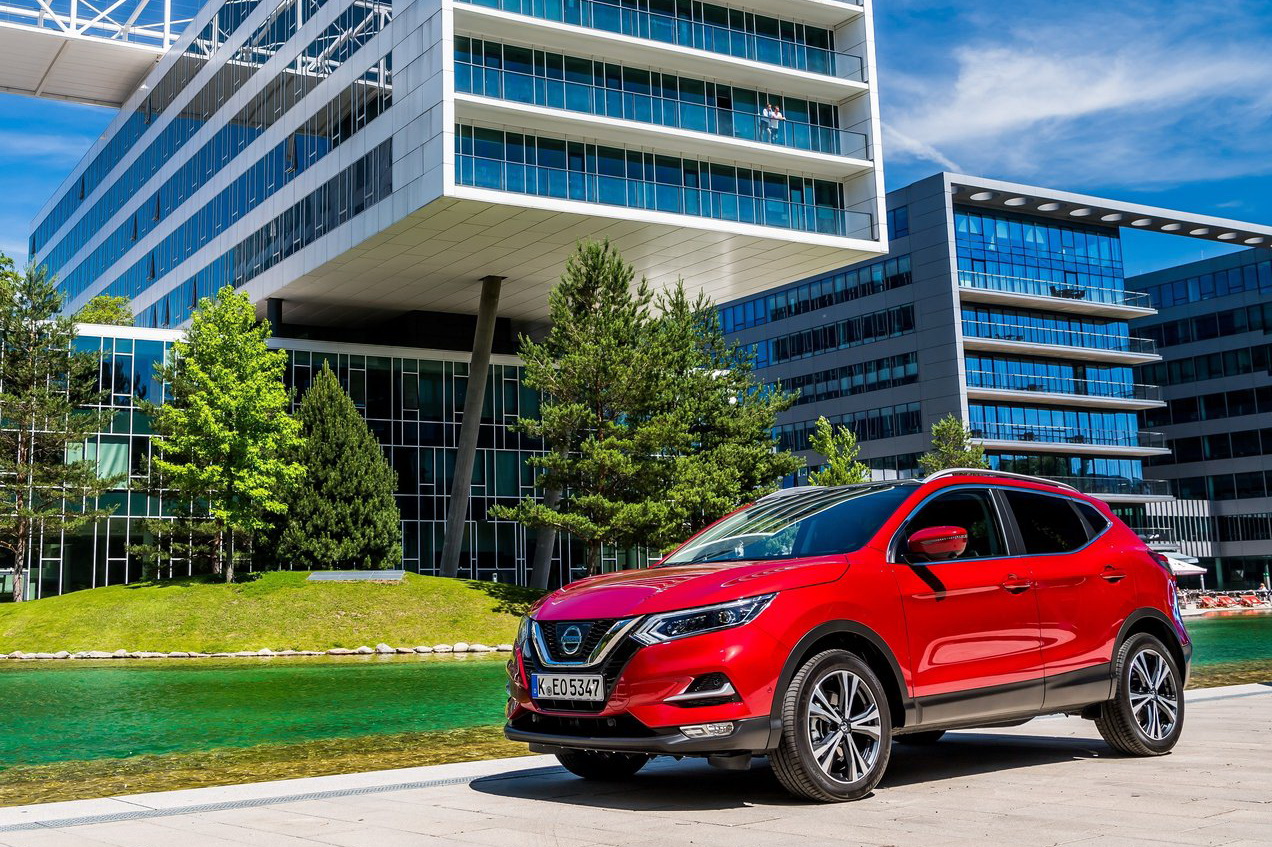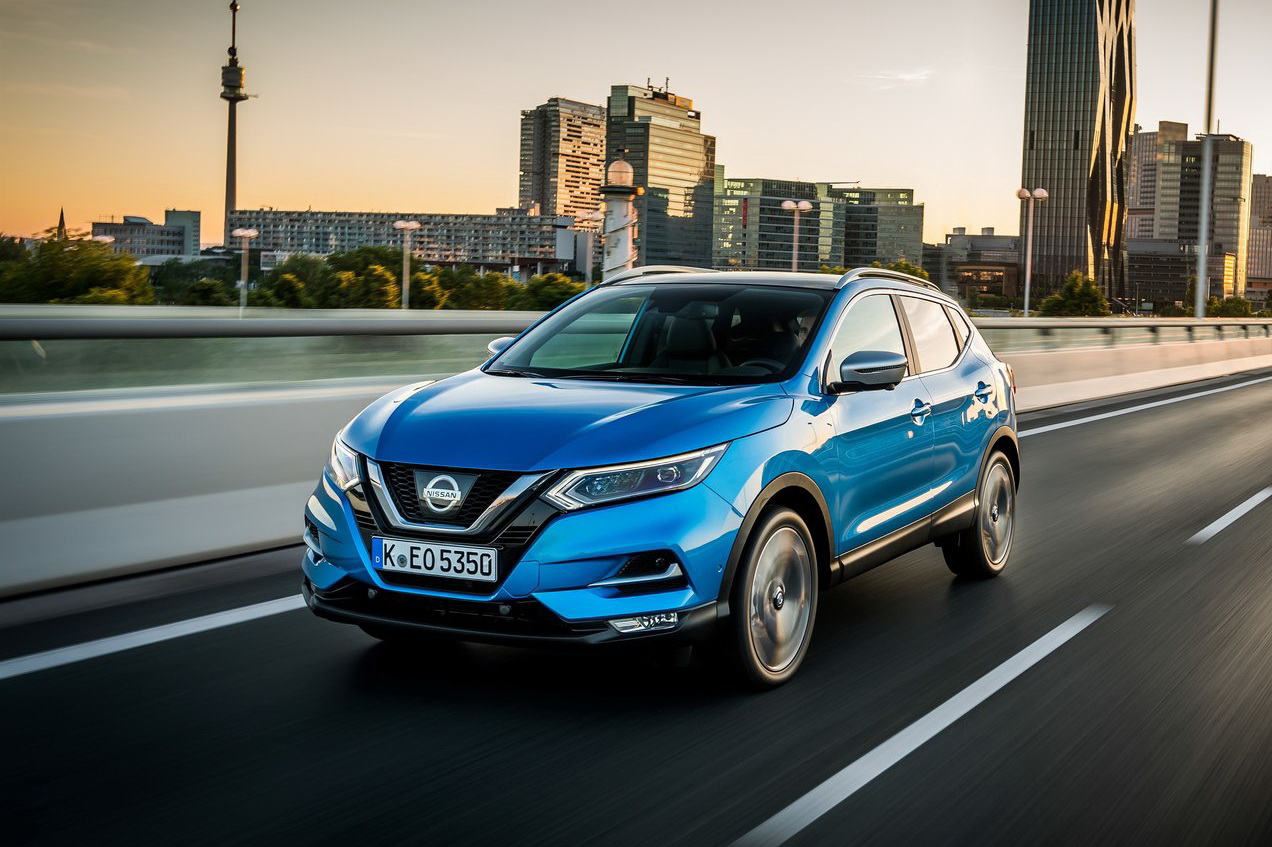

The ultimate Qashqai: Tekna+ creates exclusive new premium choice for customers
New to the Nissan Qashqai range is the addition of a fifth grade, Tekna+, which sits as the flagship of the line-up above Visia, Acenta, N-Connecta and Tekna. With exclusive new premium features as standard, Tekna+ is aimed at buyers seeking the ultimate Qashqai.
In the cabin, the new premium seats are trimmed in the highest-quality soft nappa leather, with luxurious 3D quilting on the centre panels – a first for Nissan in Europe. The design is replicated in the rear. Black leather is standard, with the choice of a rich plum colour as a no-cost option.
The driver’s seat features electrically controlled four-way pneumatic lumbar support – another first for Nissan Europe. This allows drivers of all sizes to fine-tune their seating position, enhancing comfort and reducing fatigue. A seat memory function with two stored positions has been added, linked to the door mirrors. This is a unique feature on any Nissan Europe model today, with operation via buttons on the seat’s lower finisher.
Standard on Tekna+ is the new BOSE Premium eight-speaker audio system.
Externally, Tekna+ comes with premium satin silver door mirror caps and roof rails.
Interior enhancements boost new Qashqai’s premium appeal
The impact of the premium upgrades to the Nissan Qashqai is most obvious in the cabin. They have resulted in the highest levels of perceived quality and refinement, a more driver-oriented interior and an enhanced feeling of total control.
At the heart of redesigned front face of the Qashqai is the latest incarnation of Nissan’s iconic ‘V-motion’ grille, which frames the new Nissan badge. There are two versions of the badge. From N-Connecta it has a completely flat finish; this is because the upgraded radar which forms part of the Qashqai’s Intelligent Emergency Braking (IEB) system is now located behind it. A flat finish allows radar waves to pass through it unhindered. Previously the radar was fitted lower down the grille and to one side. A second version of the badge, contoured in a more traditional way, is fitted to cars without IEB.
Barely noticeable thanks to innovative Nissan engineering, the grille’s chrome surround now houses the front camera that provides part of the image for the car’s Intelligent Around View Monitor, Nissan’s innovative 360° parking camera system. Previously it was part of the Nissan badge.
On ride comfort, the priority was calmer body motion and improved impact shock. This was achieved by retuning the dampers, reducing the single wheel spring rate, and modifying rubber components. The anti-roll bar stiffness has been increased to maintain handling performance. There is now reduced body motion when going over large bumps thanks to changes to the car’s Active Ride Control system.
To enhance handling, the engineering team has created a more secure feel and improved line traceability through corners. This has been achieved with a new thicker steering shaft and changes to the steering effort build-up around dead centre.
On steering, a new technology called Active Return Control means the steering wheel now returns to centre more naturally, with improved precision during driving. The assembly behind the new steering wheel features a new dynamic damper which has resulted in less vibration reaching the driver’s hands.

Improved NVH refinement for an enhanced customer experience
There are significant improvements to noise, vibration and harshness (NVH) performance on the new Qashqai. More sound insulation material, and material of a higher quality, has been added inside the front doors and behind the rear wheel arches. Additional sealing around the front doors has been integrated, while the rear door glass is now thicker – from 3.15mm to 3.85mm – to improve the rear passenger experience.
The result is that road and wind noise in the cabin have been reduced on every Qashqai model. There is also less engine noise ingress on the 1.6-litre diesel thanks to powertrain calibration improvements.
For customers, the quieter cabin creates a more premium feeling and lowers fatigue levels. It also improves the audio experience and performance of the Bluetooth hands-free telephone. The change has been quantified by Nissan engineers as a 5% improvement in speech intelligibility during in-car conversation, which is a significant step.
Aerodynamic performance has always been a strong part of the Qashqai package and contributes to low running costs for drivers. Even after so many exterior design changes, the new model retains its drag coefficient of 0.32 – among the best in the class.

New Nissan Intelligent Mobility technologies, including ProPILOT autonomous drive
Nissan Intelligent Mobility is the name for the brand’s advanced technologies which make its cars more desirable by redefining how they are driven, powered and integrated into society. The goal is to make Nissan drivers feel more confident, excited and connected, while also enhancing road safety.
Since its launch in 2007, the Nissan Qashqai has been at the heart of Nissan’s desire to democratise this technology. With the launch of the new Qashqai, that commitment to customers is extended even further.
In Q4 FY17 Nissan will introduce ProPILOT on the new Qashqai. It’s the first stage of the brand’s journey to autonomous driving, giving drivers more freedom by allowing them to automate the mundane elements of their motoring life if they wish.
ProPILOT will control the steering, acceleration and braking in a single lane on highways during heavy traffic congestion and high-speed cruising. It is based on three technologies – Lane Keep Assist (LKA), Intelligent Cruise Control (ICC) and Traffic Jam Pilot (TJP). Intuitive to use, ProPILOT will be activated via a button on the Qashqai’s steering wheel. Information will be displayed in the combimeter between the instrument dials. Further details on ProPILOT will be given nearer to its launch.
The new Qashqai maintains its 2014 five-star Euro NCAP safety rating.

Efficient powertrains, including class-leading 99g/km CO2 emissions
The Nissan Qashqai’s range of efficient engines has been carried over, offering the choice of petrol or diesel, six-speed manual or CVT XTronic automatic transmissions, and two or four-wheel drive to meet every type of customer need. The line-up includes the 1.5-litre 110PS diesel which, with CO2 emissions of just 99g/km and fuel economy of only 3.8 litres/100km, is the segment leader.
Standard equipment, options and accessories
Every new Nissan Qashqai comes with six airbags as standard, plus driver assistance systems including anti-lock brakes, electronic brakeforce distribution and stability control. Other standard equipment includes manual air-conditioning, Tyre Pressure Monitoring System, DAB digital radio (in most markets), Bluetooth connectivity, cruise control with speed limiter, and electrically adjustable heated door mirrors.
Depending on the grade chosen, available features include dual-zone climate control, automatic headlights and wipers, folding door mirrors and privacy glass. Many of the higher-grade features are available as optional extras on lower grades. Additional options include the full-length panoramic glass roof with one-touch shade, exterior styling plates and side styling bars. Genuine Nissan accessories include a dog guard, roof bars and a fixed towbar with electric hook-up.







The ultimate Qashqai: Tekna+ creates exclusive new premium choice for customers New to the Nissan Qashqai range is the addition of a fifth grade, Tekna+, which sits as the flagship of the line-up above Visia, Acenta, N-Connecta and Tekna. With exclusive new premium features as standard, Tekna+ is aimed at buyers seeking the ultimate Qashqai. In the cabin, the new premium seats are trimmed in the highest-quality soft nappa leather, with luxurious 3D quilting on the centre panels - a first for Nissan in Europe. The design is replicated in the rear. Black leather is standard, with the choice of a rich plum colour as a no-cost option. The driver's seat features electrically controlled four-way pneumatic lumbar support - another first for Nissan Europe. This allows drivers of all sizes to fine-tune their seating position, enhancing comfort and reducing fatigue. A seat memory function with two stored positions has been added, linked to the door mirrors. This is a unique feature on any Nissan Europe model today, with operation via buttons on the seat's lower finisher. Standard on Tekna+ is the new BOSE Premium eight-speaker audio system. Externally, Tekna+ comes with premium satin silver door mirror caps and roof rails. Interior enhancements boost new Qashqai's premium appeal The impact of the premium upgrades to the Nissan Qashqai is most obvious in the cabin. They have resulted in the highest levels of perceived quality and refinement, a more driver-oriented interior and an enhanced feeling of total control. At the heart of redesigned front face of the Qashqai is the latest incarnation of Nissan's iconic 'V-motion' grille, which frames the new Nissan badge. There are two versions of the badge. From N-Connecta it has a completely flat finish; this is because the upgraded radar which forms part of the Qashqai's Intelligent Emergency Braking (IEB) system is now located behind it. A flat finish allows radar waves to pass through it unhindered. Previously the radar was fitted lower down the grille and to one side. A second version of the badge, contoured in a more traditional way, is fitted to cars without IEB. Barely noticeable thanks to innovative Nissan engineering, the grille's chrome surround now houses the front camera that provides part of the image for the car's Intelligent Around View Monitor, Nissan's innovative 360° parking camera system. Previously it was part of the Nissan badge. On ride comfort, the priority was calmer body motion and improved impact shock. This was achieved by retuning the dampers, reducing the single wheel spring rate, and modifying rubber components. The anti-roll bar stiffness has been increased to maintain handling performance. There is now reduced body motion when going over large bumps thanks to changes to the car's Active Ride Control system. To enhance handling, the engineering team has created a more secure feel and improved line traceability through corners. This has been achieved with a new thicker steering shaft and changes to the steering effort build-up around dead centre. On steering, a new technology called Active Return Control means the steering wheel now returns to centre more naturally, with improved precision during driving. The assembly behind the new steering wheel features a new dynamic damper which has resulted in less vibration reaching the driver's hands.

Improved NVH refinement for an enhanced customer experience There are significant improvements to noise, vibration and harshness (NVH) performance on the new Qashqai. More sound insulation material, and material of a higher quality, has been added inside the front doors and behind the rear wheel arches. Additional sealing around the front doors has been integrated, while the rear door glass is now thicker - from 3.15mm to 3.85mm - to improve the rear passenger experience. The result is that road and wind noise in the cabin have been reduced on every Qashqai model. There is also less engine noise ingress on the 1.6-litre diesel thanks to powertrain calibration improvements. For customers, the quieter cabin creates a more premium feeling and lowers fatigue levels. It also improves the audio experience and performance of the Bluetooth hands-free telephone. The change has been quantified by Nissan engineers as a 5% improvement in speech intelligibility during in-car conversation, which is a significant step. Aerodynamic performance has always been a strong part of the Qashqai package and contributes to low running costs for drivers. Even after so many exterior design changes, the new model retains its drag coefficient of 0.32 - among the best in the class.
 New Nissan Intelligent Mobility technologies, including ProPILOT autonomous drive
Nissan Intelligent Mobility is the name for the brand's advanced technologies which make its cars more desirable by redefining how they are driven, powered and integrated into society. The goal is to make Nissan drivers feel more confident, excited and connected, while also enhancing road safety.
Since its launch in 2007, the Nissan Qashqai has been at the heart of Nissan's desire to democratise this technology. With the launch of the new Qashqai, that commitment to customers is extended even further.
In Q4 FY17 Nissan will introduce ProPILOT on the new Qashqai. It's the first stage of the brand's journey to autonomous driving, giving drivers more freedom by allowing them to automate the mundane elements of their motoring life if they wish.
ProPILOT will control the steering, acceleration and braking in a single lane on highways during heavy traffic congestion and high-speed cruising. It is based on three technologies - Lane Keep Assist (LKA), Intelligent Cruise Control (ICC) and Traffic Jam Pilot (TJP). Intuitive to use, ProPILOT will be activated via a button on the Qashqai's steering wheel. Information will be displayed in the combimeter between the instrument dials. Further details on ProPILOT will be given nearer to its launch.
The new Qashqai maintains its 2014 five-star Euro NCAP safety rating.
New Nissan Intelligent Mobility technologies, including ProPILOT autonomous drive
Nissan Intelligent Mobility is the name for the brand's advanced technologies which make its cars more desirable by redefining how they are driven, powered and integrated into society. The goal is to make Nissan drivers feel more confident, excited and connected, while also enhancing road safety.
Since its launch in 2007, the Nissan Qashqai has been at the heart of Nissan's desire to democratise this technology. With the launch of the new Qashqai, that commitment to customers is extended even further.
In Q4 FY17 Nissan will introduce ProPILOT on the new Qashqai. It's the first stage of the brand's journey to autonomous driving, giving drivers more freedom by allowing them to automate the mundane elements of their motoring life if they wish.
ProPILOT will control the steering, acceleration and braking in a single lane on highways during heavy traffic congestion and high-speed cruising. It is based on three technologies - Lane Keep Assist (LKA), Intelligent Cruise Control (ICC) and Traffic Jam Pilot (TJP). Intuitive to use, ProPILOT will be activated via a button on the Qashqai's steering wheel. Information will be displayed in the combimeter between the instrument dials. Further details on ProPILOT will be given nearer to its launch.
The new Qashqai maintains its 2014 five-star Euro NCAP safety rating.

Efficient powertrains, including class-leading 99g/km CO2 emissions The Nissan Qashqai's range of efficient engines has been carried over, offering the choice of petrol or diesel, six-speed manual or CVT XTronic automatic transmissions, and two or four-wheel drive to meet every type of customer need. The line-up includes the 1.5-litre 110PS diesel which, with CO2 emissions of just 99g/km and fuel economy of only 3.8 litres/100km, is the segment leader. Standard equipment, options and accessories Every new Nissan Qashqai comes with six airbags as standard, plus driver assistance systems including anti-lock brakes, electronic brakeforce distribution and stability control. Other standard equipment includes manual air-conditioning, Tyre Pressure Monitoring System, DAB digital radio (in most markets), Bluetooth connectivity, cruise control with speed limiter, and electrically adjustable heated door mirrors. Depending on the grade chosen, available features include dual-zone climate control, automatic headlights and wipers, folding door mirrors and privacy glass. Many of the higher-grade features are available as optional extras on lower grades. Additional options include the full-length panoramic glass roof with one-touch shade, exterior styling plates and side styling bars. Genuine Nissan accessories include a dog guard, roof bars and a fixed towbar with electric hook-up.

































